Living seriously offgrid as we do has many advantages and low-cost pleasures but one of the challenges we haven’t enjoyed so much is not being able to vacuum our floors as often as we would like. We have a regular house size upright vacuum cleaner which is very nice but we have just never had enough offgrid power to run it! We were considering buying one of those ‘rechargeable’ vacuums — something we could plug into our existing 300 watt pure sine wave inverter. Then with Christmas upon us and our anniversary only two months away, we thought, “Why not do a joint Christmas/Anniversary gift to each other and take our solar system to the next level?” So that’s exactly what we did. Because we have had such great luck with our Go Power! brand 300 watt inverter we ordered the biggest inverter that company makes = 3,000 watts (ten times the AC potential of our little inverter). Not to get too technical, but inverters ‘waste’ a bit of power inverting 12 volt DC to 120 volt AC. With lesser loads, it’s more efficient but at full load, our new inverter is only about 82% efficient which means it must draw 18% more power than it delivers. 3,000 watts divided by 12 volt is 250 amps so we fused and sized our cabling for 300 amps to compensate for the extra draw from the batteries. We ordered pre-made cables in the 2/0 size but were still surprised when we got them how big and heavy duty these cables are.
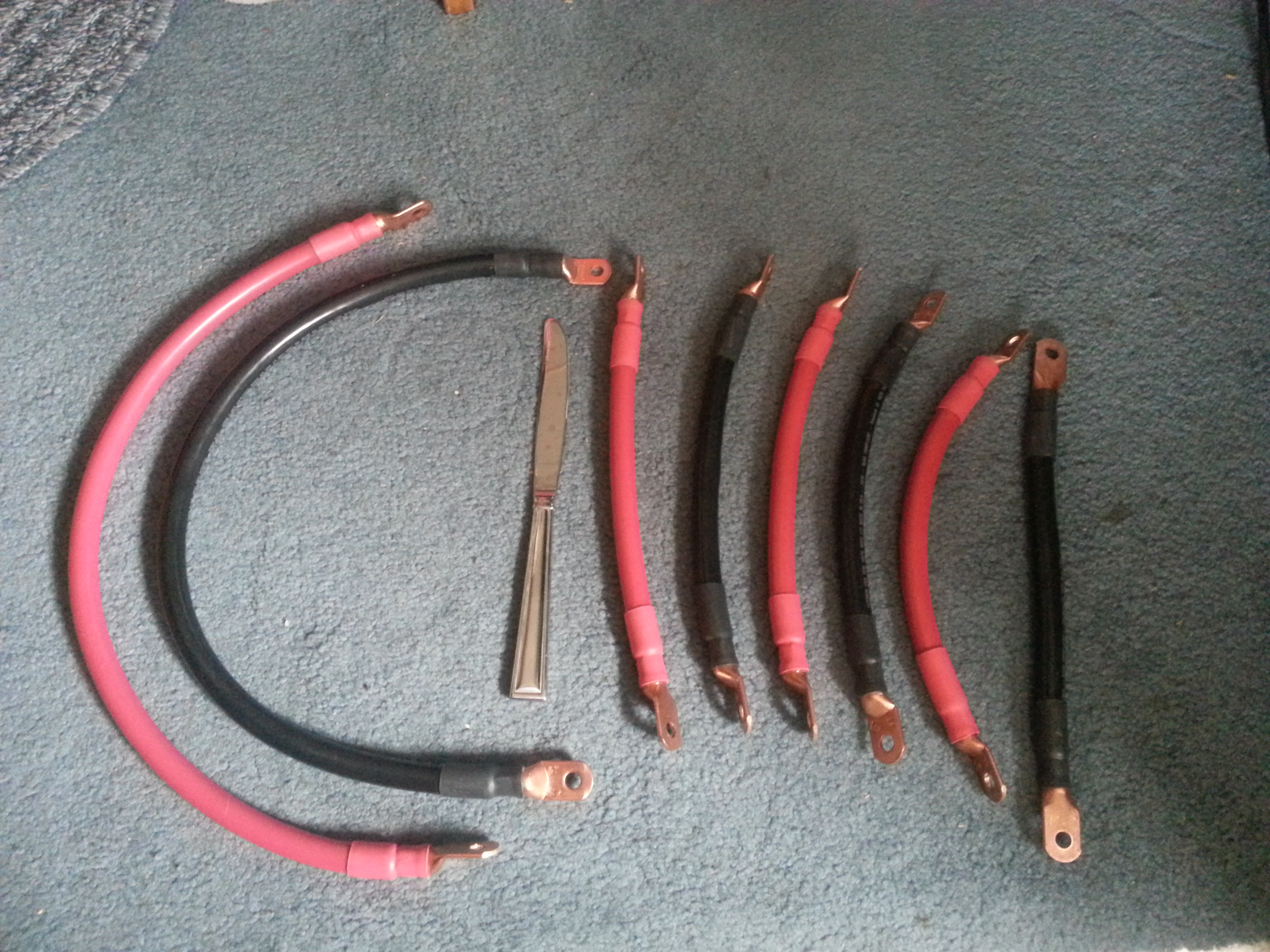
To fully appreciate how much bigger these cables are, here is one of the new cables alongside one of the 6 gauge cables we used before. The 6 gauge cables are good for 55 amps but we knew (with our small 300 watt inverter) that we’d never pull more than 30 amps so they were plenty big enough for the small inverter.
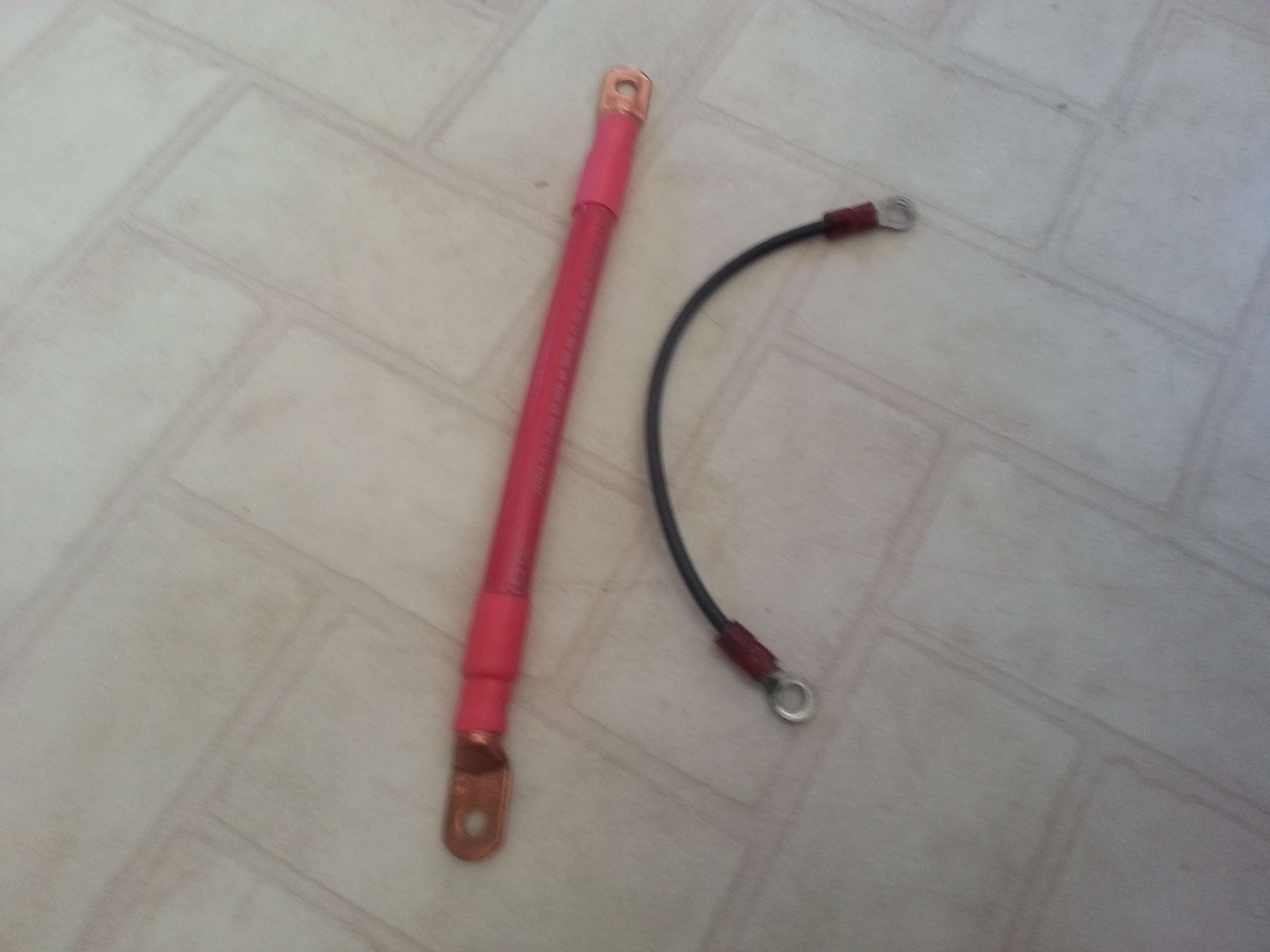
Removing the skinny “old” cables and installing the new pre-made cables (from custombatterycables.com) wasn’t too tough but I ordered all the cables with 5/16″ terminals on both ends and learned during the install that two of our four batteries have 3/8″ threaded studs on the positive side. Fortunately the terminal ends are copper so it was easy enough to drill out the four terminals I needed to the larger 3/8″ hole. I also am no longer fond of the stock wing nuts and went with regular nuts I could easily tighten with a wrench instead. I also added lock washers when there was enough room for them.
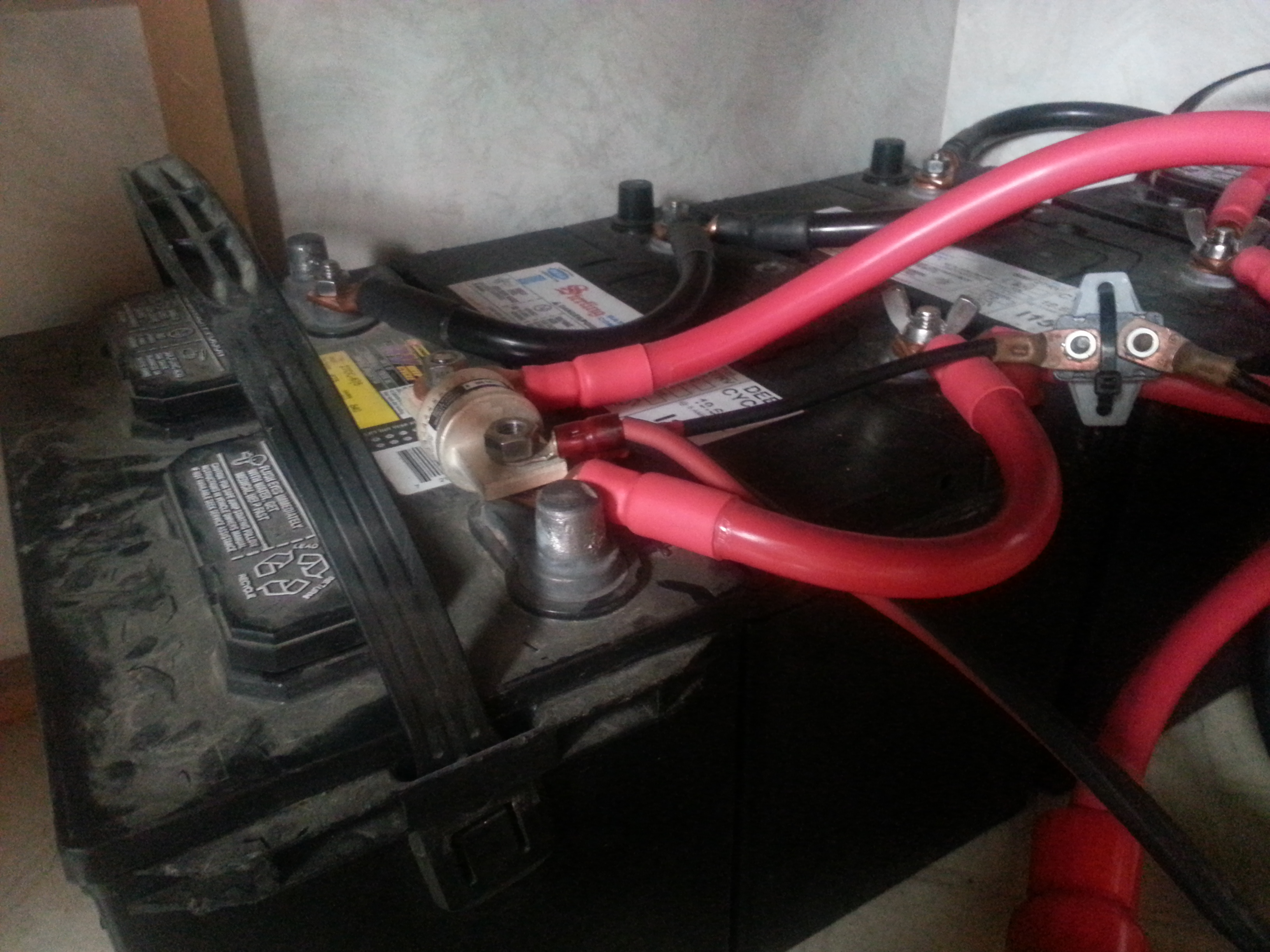
In the image, you can still see two large wingnuts but that’s only because I didn’t have any 3/8″ nuts on hand at the time. I did tighten them with a wrench anyway but they will get replaced with lock washers and nuts next time I’m working with them. (Once a year we basically take the whole bank apart so that each battery can be tested separately.) I also had to reroute the positive charge cable *and* the positive cable feeding the 12 volt fuse panel. Each of these cables is 6 gauge and has its own 50 amp circuit breaker with a manual reset button. I was able to screw one of them to the OEM cord box but the other one I simply zip-tied in place where it ended up. It may be worth mentioning here that one must be *extremely* careful when working with banks of batteries like this. Wrenches are metal and you do *NOT* want them shorting out between positive and negative at *ANY* time. I didn’t take this precaution but it would be a very smart move to use electrical tape and tape off all but the business end of any wrench that you use. It’s also a good idea to remove any jewelry from your fingers or wrists. Gold is a GREAT conductor and will get hot enough to burn flesh very quickly. You’re supposed to hook up the chassis ground wire to the inverter *and* bolt up the negative cable *BEFORE* bolting up the positive cable. To keep disaster at bay, I actually taped up the loose ends of both long cables (running from the bank of batteries to the inverter) and only untaped those ends immediately prior to bolting each one to the input terminal on the inverter. Even following the install directions to the letter, I still got a significant SPARK when I made the final connection to the inverter (with it turned OFF of course). This is to be expected as there is a large capacitor inside the inverter and capacitors charge (pulling significant power) in a nano-second. Even though I was expecting it, the SPARK still surprised me — not particularly hazardous I suppose but no less unsettling. 🙂
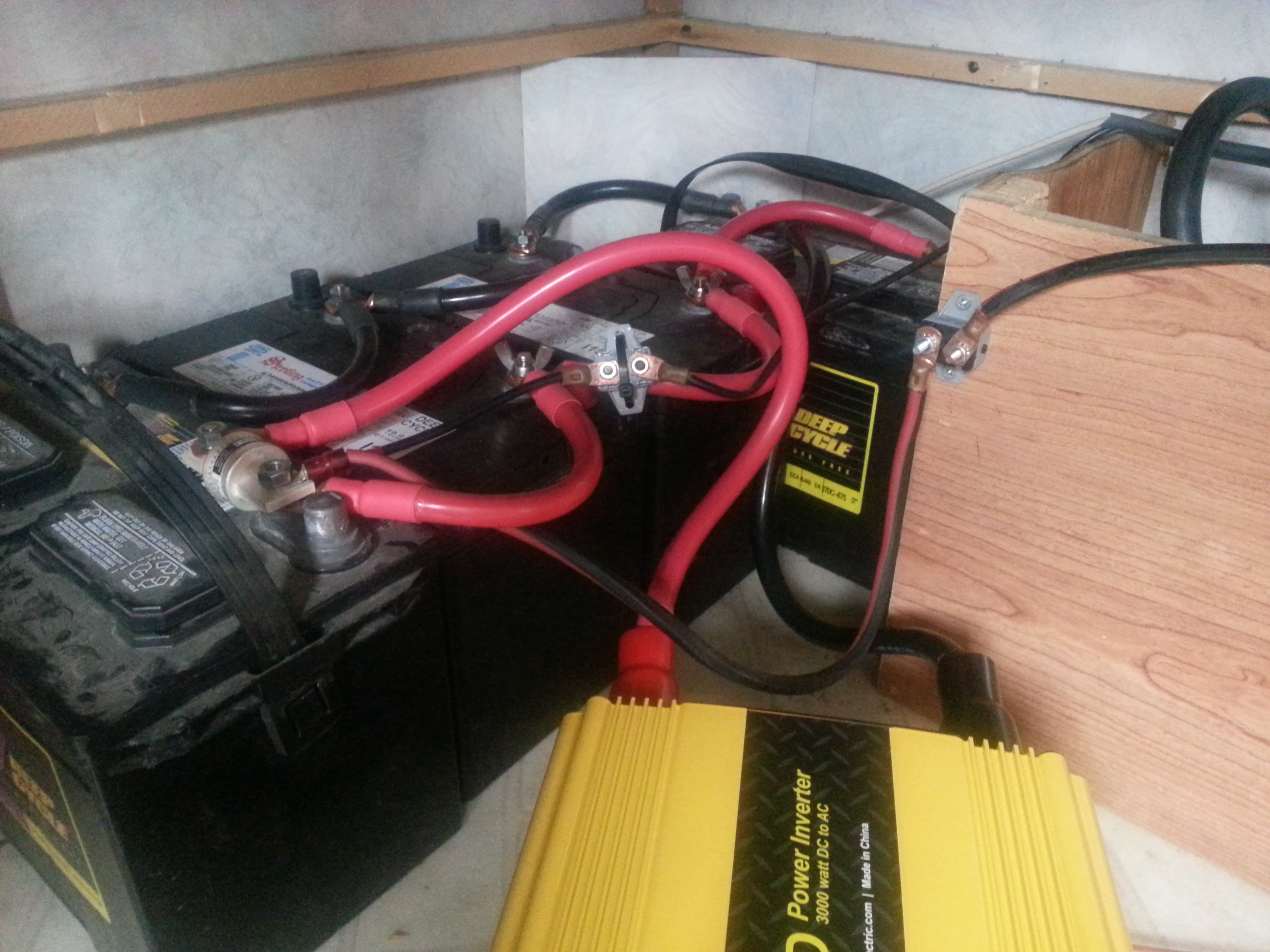
I was surprised to see how large a 300 amp fuse is:
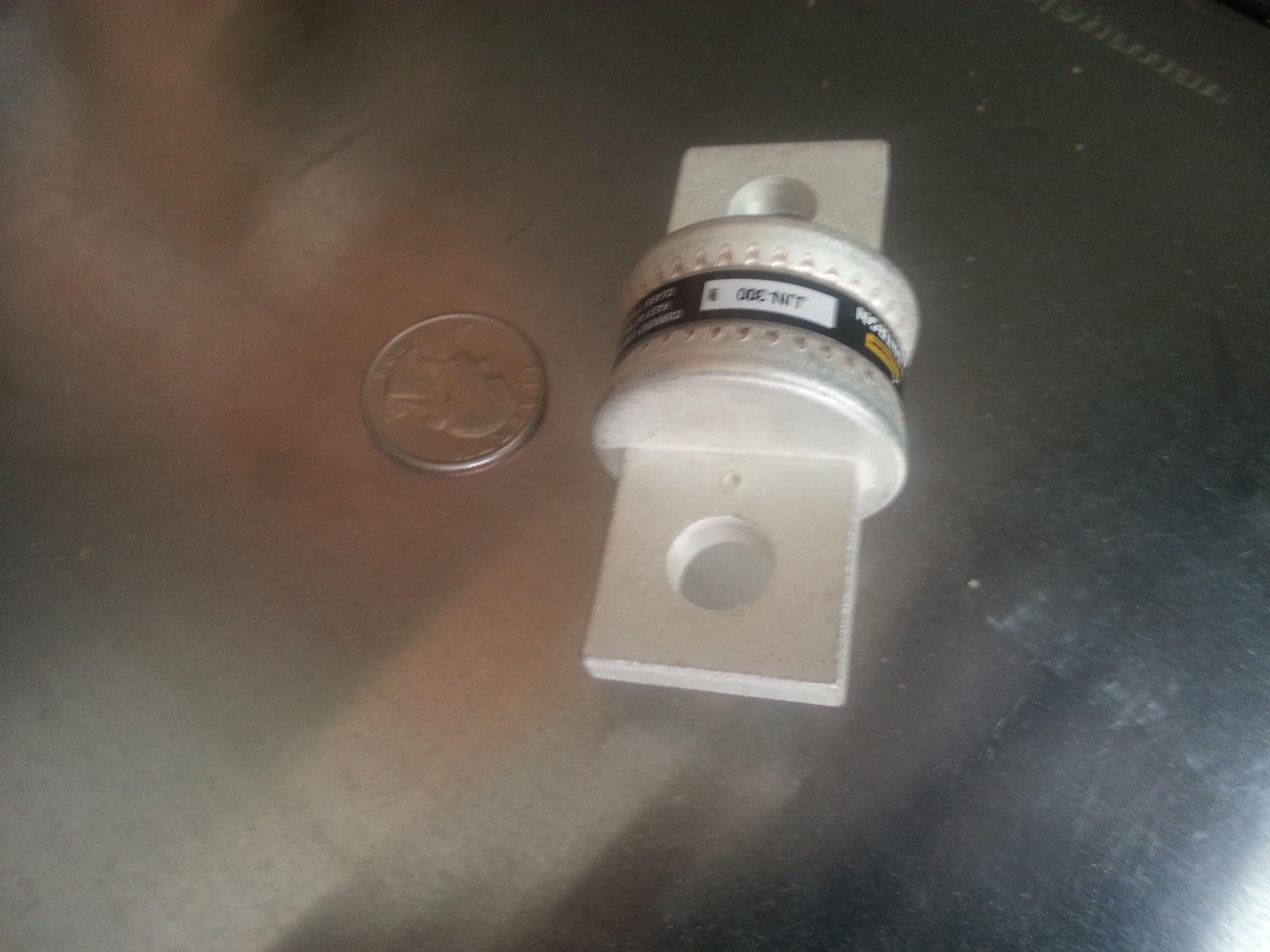 I couldn’t bolt the fuse direct to the threaded stud on the battery without putting washers under the fuse terminal. Then I remembered that *all* fuses are resisters and they cause measureable voltage drop. So I put the terminals for the cables from the charge controller *and* the 12 volt power going back out to the fuse box *under* the fuse terminal on one end and bolted it up tight. Then I rerouted the large positive cable a bit and bolted it to the terminal at the other end of the fuse. In this fashion, the feed cable is protected *but* the charging power to the batteries *and* the power going back out to the 12 volt fuse panel do NOT go through the large fuse. I should note here that pulling power from a bank of batteries diagonally (as opposed to having both primary cables at the same end of a bank) pulls power quite equally from ALL the batteries in a bank. (There are actually two other cabling scenarios which pull power even *more* equally but it’s tough to justify the cabling complexity for such a minor improvement.] One should also pull power from *and* charge any bank of batteries at the *SAME* two terminals. No exceptions. If you look again at the image above (just above the one of the fuse), you can kinda’ see how the red primary feed to the inverter comes from the near left positive terminal and the black primary feed comes from the far right negative terminal back in the corner.
I couldn’t bolt the fuse direct to the threaded stud on the battery without putting washers under the fuse terminal. Then I remembered that *all* fuses are resisters and they cause measureable voltage drop. So I put the terminals for the cables from the charge controller *and* the 12 volt power going back out to the fuse box *under* the fuse terminal on one end and bolted it up tight. Then I rerouted the large positive cable a bit and bolted it to the terminal at the other end of the fuse. In this fashion, the feed cable is protected *but* the charging power to the batteries *and* the power going back out to the 12 volt fuse panel do NOT go through the large fuse. I should note here that pulling power from a bank of batteries diagonally (as opposed to having both primary cables at the same end of a bank) pulls power quite equally from ALL the batteries in a bank. (There are actually two other cabling scenarios which pull power even *more* equally but it’s tough to justify the cabling complexity for such a minor improvement.] One should also pull power from *and* charge any bank of batteries at the *SAME* two terminals. No exceptions. If you look again at the image above (just above the one of the fuse), you can kinda’ see how the red primary feed to the inverter comes from the near left positive terminal and the black primary feed comes from the far right negative terminal back in the corner.
In this image, you can see that the ‘hard wires’ from the inverter were *barely* long enough to run them direct to the new RV-style 30 amp outlet which I installed.
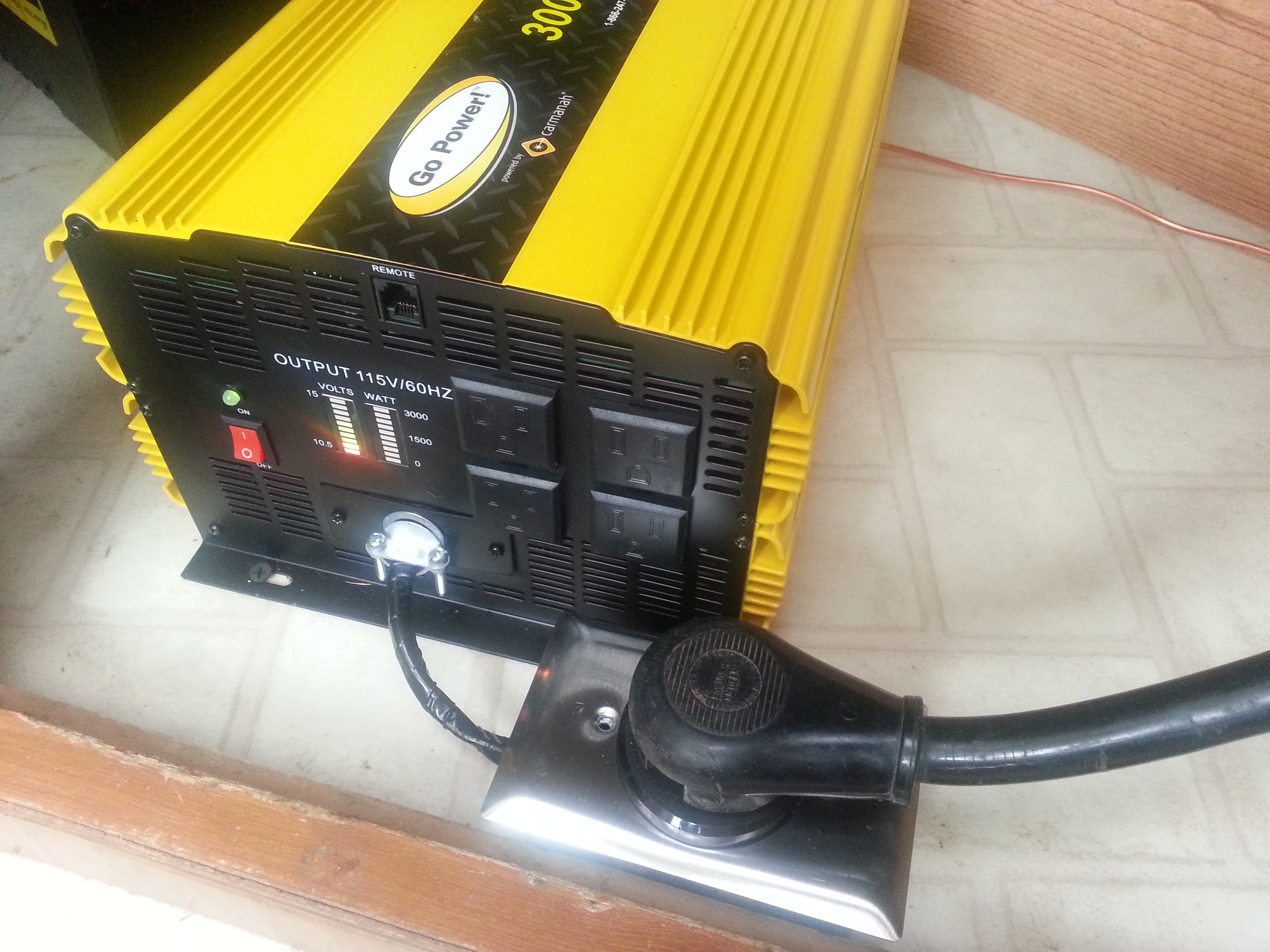 One advantage of setting up our added outlet in this way is that no wires or connections are added. The smaller AC wires (10 gauge ‘hot’ wires and even smaller ground wire) from the inverter go direct to the outlet. This keeps things simpler *and* no chance for added wire nuts to loosen up over time due to vibration and seriously lumpy California roads! Another advantage of adding this outlet is we can plug in our regular 25′ power cord — just like we would if we were staying in an RV park — so doing it this way preserves that option and keeps things *stock* as much as possible. A 3rd advantage is this saves the four AC outlets on the front of the inverter itself for other uses while also powering up every AC outlet or appliance in the house.
One advantage of setting up our added outlet in this way is that no wires or connections are added. The smaller AC wires (10 gauge ‘hot’ wires and even smaller ground wire) from the inverter go direct to the outlet. This keeps things simpler *and* no chance for added wire nuts to loosen up over time due to vibration and seriously lumpy California roads! Another advantage of adding this outlet is we can plug in our regular 25′ power cord — just like we would if we were staying in an RV park — so doing it this way preserves that option and keeps things *stock* as much as possible. A 3rd advantage is this saves the four AC outlets on the front of the inverter itself for other uses while also powering up every AC outlet or appliance in the house.
VERY CRITICAL NOTE: I’m not sure I fully wrap my mind around this issue yet *BUT* one of the very unique things about MSW (Modified Sine Wave) inverters is there are only three wires coming out for the “hard wire” option. One of them is small and green = ground = easy enough to figure out. It connects to the round hole on the RV-style 30 amp outlet and I was able to confirm the outlet also grounds the metal box it is in *and* the metal trim cover without having to add a ground wire to the box itself. What’s weird is there is no neutral wire! Both of the two remaining wires are HOT *and* interchangeable. Each of them will measure 60 volts so they get together at the various outlets and make their 120 volts there. I am NOT an electrical guru so I won’t attempt to explain this bit of magic *BUT* it means there must be absolutely NO continuity between your AC ground and your AC neutral bars in your AC power panel in the RV or you will have a direct short! Please note that in regular house panels, both the ground bar AND the neutral bar ARE bolted to the same metal box. This means they are “bonded” to each other and such a scenario will *IMMEDIATELY* destroy your shiny brand-new inverter with absolutely ZERO recourse against the manufacturer of said inverter. Fortunately — if you look *very* closely — your RV power supply panel (on the AC side where the circuit breakers are) should have a thin black plastic plate *under* the neutral bar (the metal piece which all the white wires are screwed to). That thin black plastic plate electrically insulates the neutral bar away from the ground . . . meaning the two are NOT “bonded” (yay!) and there is NO continuity between them. If you’ve read this far and are even remotely considering installing your own system like we did, you need to fully understand how to use a tester to check for continuity FIRST. Once you’ve wrapped your mind around that test, you can check for continuity between the ground prong of your 30 amp RV cord and either of the two other prongs and you should have NO continuity at all. Check and double-check and triple-check. $350 or whatever you paid for *your* inverter is absolutely at stake. Once you’re confident that your neutral and ground are *NOT* bonded . . . only then can you plug your cord into the added 30 amp outlet. Not to belabor this point too much, but this is *EXTREMELY* important! Make a mistake on this and you’re simply gonna’ be OUT whatever your inverter cost . . . again with no recourse OR warranty satisfaction on this front. Consider yourself duly warned! I’ve read about folks trying to power up a remote cabin somewhere who toasted THREE inverters! Based on their comments, it’s clear they never did figure out what was causing the inverters to fail. Please don’t add your name to the eternally frustrated list. This warning is specific to ‘most’ MSW (Modified Sine Wave) inverters ONLY — read and follow *your* installation instructions carefully. If you’re installing a large PSW (Pure Sine Wave) inverter, follow the installation guidelines for your particular inverter *very* carefully. [Also see note #7 in FURTHER TECHNICAL NOTES below.]
So — moving on — if you do everything right, this is your reward:
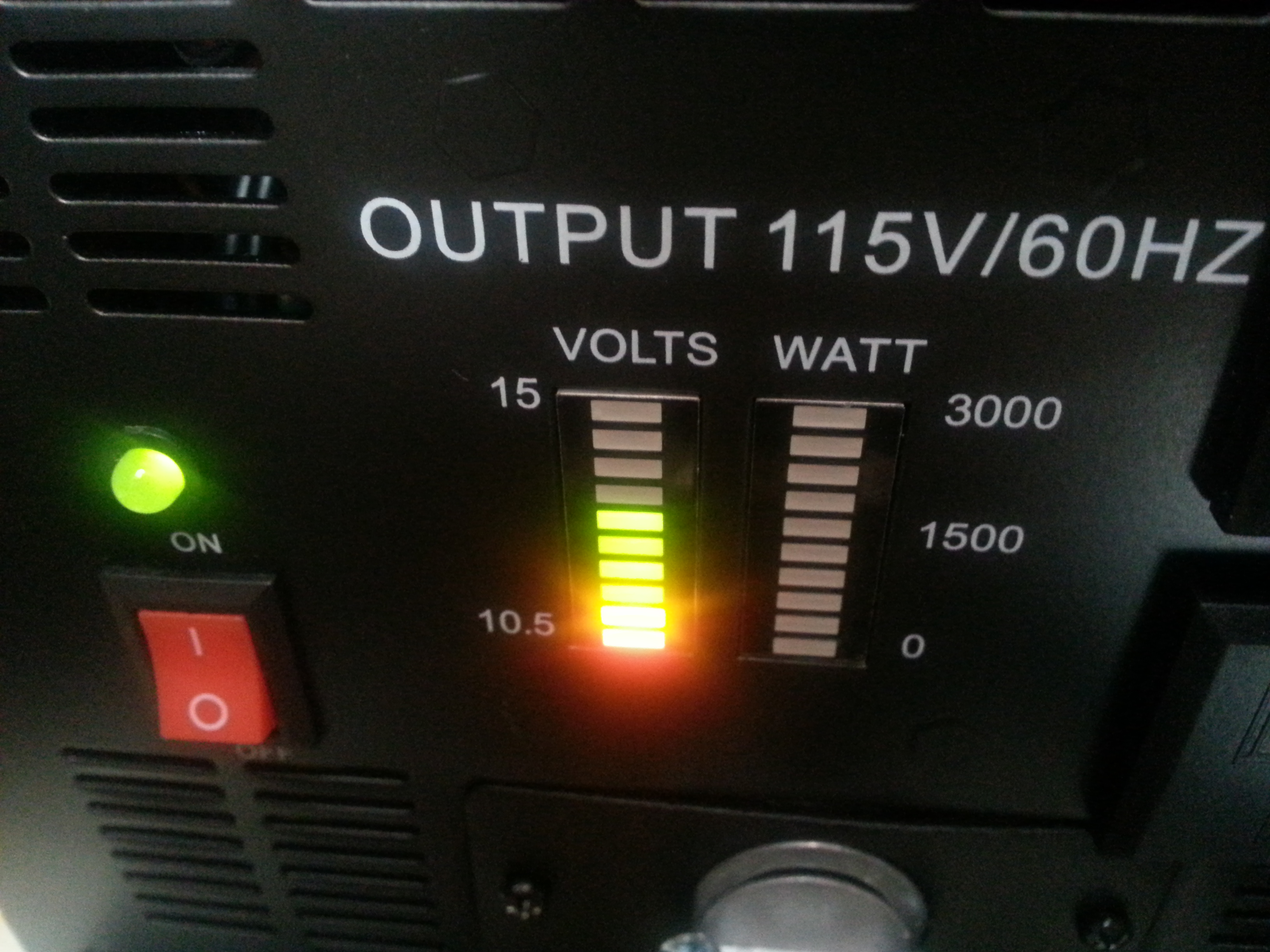
And how sweet it is! Keep in mind we now have the ability to drain our batteries ten times (actually 11 times when we include the small inverter) faster than ever before. An inverter doesn’t give you any more power than you ever already had. It only makes it much easier to USE that power in big gulps and drain your batteries with frightening speed. One little design maxim is to take your inverter output and divide by 5 (3,000 divided by 5 — in our case — is 600). This is considered the *minimum* amp hours of batteries one should have to reasonably support an inverter of any given size. For easy figuring, we rate each battery at 100 amp hours. This means we should have six batteries in our bank but we only have four. 🙁 The system will work fine just the way it is but, of course, four batteries can only store 2/3 of the power that six would. We will likely add two more batteries soon enough . . . and we may learn that even six batteries is not enough ‘reserve’ to support our *new* power-enhanced lifestyle. But we can always add more . . . at least until our 420 watt panel is no longer able to keep them all charged up on a daily basis. Making any one upgrade or change almost always just moves the ‘weakest link’ to some other part of the system. We have been *very* happy with solar power even with our tiny 300 watt inverter for over 14 months. But it is exciting to consider how this newest addition to our lifestyle might change some of our daily routines. Having lived offgrid this long with 300 watts of AC power, it’s a little crazy to consider that we now actually have a total of 11 times(!) that much AC power available to us . . . for short bursts if nothing else — as long as the batteries hold out that is. 🙂 If you’re a full-timer like us, would this be enough power for you or would you still feel the need for more? Please feel free to add any questions or comments. We read them all *and* respond to each one. 🙂
FURTHER TECHNICAL NOTES:
(1) With a conventional RV setup, there is an unfortunate issue with the converter. For a “whole house” system like ours, the converter pulls power from the 120 volt AC inverter, then converts it to 12 volt DC, then feeds that power to the batteries which feed the inverter and round and round we go with efficiency losses every step of the way until the batteries are dead (or dying) and all we’ve accomplished is giving off a bunch of HEAT (which may or may not be considered a “good” thing). Some folks resolve this problem by flipping the circuit breaker to their converter OFF and leaving it OFF whenever the inverter is ON. There are also magical automatic switches (and magical prices to go with them *and* their installation!) to protect against this conflict. In our case, we are almost never plugged in anyway. At some point, our converter developed a minor issue with a sticking solenoid switch (likely due to lack of use as much as anything) so I just removed the pot licker and stashed it in our storage shed back ‘home’ — end of problem! Besides *most* converters are lame battery chargers in any event — most often just a two or three amp unregulated feed which only works when you’re plugged into grid power (which, again, we almost never are).
(2) We also leave the circuit breaker for our rooftop AC turned OFF to guard against any accidental attempts to run the rooftop AC from our battery bank. It’s just not practical to ever consider running rooftop AC with solar power. This also applies to furnace blowers (we no longer use our OEM furnace either), electric heaters and all the other energy PIGS — some appliances are just NOT a good match for solar and IMHO never will be. If we have a chance to plug our main power cord into what we call “shore power” (a boating term but it just means plugging into the grid) and we want to run the rooftop AC, it’s a simple matter of turning the circuit breaker back ON and letting the cool breeze blow. We do plan on using our microwave now and it’s certainly an energy PIG but it pulls power for such a short amount of time that we find it doable. Keep in mind that microwaves pull 40 to 100% of their rated power. So a 1,000 watt microwave can pull up to 2,000 watts.
(3) One could also flip the AC breaker OFF for the refrigerator so it cannot default to AC in the middle of the night when you run out of propane and possibly run your batteries dead by morning, but we find it more “foolproof” to just unplug the refrigerator from its outlet (visible after removing the exterior access door). Trying to run an absorption fridge with solar power is another losing proposition (in the military, we called these “non-starters” = options not even worth considering). For serious offgrid types, either run your reefer on propane OR get a regular residential-type AC reefer *and* a pure sine wave inverter big enough to run it. Running on AC power, regular residential-type refrigerators are MUCH more efficient. With our large inverter ON, we have noticed a slight buzzing noise at the locations of either of our two interior GFI outlets — *not* at the outlets downstream from a GFI; just at the GFI itself. As the outlets seem to ‘test’ and ‘reset’ properly, we’re not going to worry about them for now. This may be something unique to the MSW inverter so we’ll keep an ear on it. 🙂
(4) Our new inverter has a “phantom load” rated as “less than or equal to 2.5 amps” even if we’re not using any AC power at all so our plan is to leave the inverter switched OFF unless we’re actually using it. This not only saves power but it should extend the life of the inverter itself. The cooling fan in our inverter only comes on as needed for cooling *but* it does run briefly when we first switch the inverter ON. I suppose this is to confirm the fan is actually working? There is a slight delay, and then the AC circuits are fully energized. We have one AC-only lamp and it’s kinda’ fun to leave it ON to observe when the AC circuits are powered on — just for demonstration purposes only. We use the flashing display on the microwave to remind us to turn the inverter OFF when we’re no longer using it. 🙂
(5) The debate over how much discharge your batteries will tolerate without “damage” rages on and I don’t want to get too deep into it here. But all the major battery manufacturers now agree that regularly discharging a battery 80% (leaving only a 20% SOC = State Of Charge) does absolutely NO damage to the battery itself. It IS true — like anything else — if you work your batteries twice as hard, they’ll only last half as long but there is absolutely ZERO economic advantage to only discharging your batteries to 50%. Please do your part to help dispel this urban myth! Allowing your batteries to discharge down to 11.8 volts permits them to do 60% more work(!) *plus* this is the energy most easily replaced when the sun comes up the next morning. Charging batteries is like airing up a tire = easy at first and then progressively harder (requires more energy) as the tire nears maximum PSI. This is why smart chargers (and the better charge controllers) do a bulk charge first and then once the batteries are recharged, ours does a two-hour “boost” at higher voltage and lower amperage. Then the 3rd phase is a “float” — which just keeps the batteries topped off until sundown.
(6) MSW inverters work plenty well enough to power up most things. The reality is that for any given size, MSW inverters are 1/3 to 1/4 the cost of PSW (Pure Sine Wave) inverters and that’s why they are popular for larger loads. Two things which do NOT play well at all with MSW inverters are chargers for cordless tools *and* compressors for regular residential-type AC refrigerators. MSW inverters are also *NOT* recommended for sensitive electronics = computers of any kind, TVs, DVD players, cell phones, etc. The MSW inverter will power up any of these appliances/devices but you can expect less than optimal performance *and* a much shorter service life. This is why we have a smaller (300 watt) pure sine wave inverter for all our more delicate devices. My cordless drill battery charger pulls 240 watts but our PSW inverter runs it just fine. In fact, the cooling fan for that smaller inverter has only come on 2 or 3 times in 14+ months. If you discover any other appliances/devices which don’t play well with MSW inverters, please make a comment below and I’ll include them in this note.
(7) My cautions against “bonding” between neutral and ground *only* apply if you’re using a MSW inverter to power up the AC power supply panel for your whole RV (by plugging your main power cord into an added 30 amp RV-style outlet). For example, our 3,000 watt inverter has four regular outlets on the front of it. We can plug whatever into any of those four outlets and NONE of this “bonding” stuff is an issue because you’re not feeding power to your AC power supply panel if you’re just plugging a device or appliance directly into the inverter itself. But if you ADD an outlet to plug in your main power supply — what I call a whole house” system — then ALL of the cautions about “bonding” DO apply. If there is a way to make this any clearer, I’ll appreciate all the help I can get. 🙂 I do NOT want anyone hooking their stuff up wrong and then faulting me for a poor outcome. Ultimately, YOU are responsible for your *own* actions and any bad consequences, injuries, bloody noses or hurt feelings are yours and yours alone to suffer through. Working with electricity can be extremely dangerous — possibly even fatal. So do *NOT* venture outside of your comfort zone. Ask someone more knowledgeable to help you. Hire a pro if you must. But don’t blame ME for trying to help for FREE . . . are we clear on this?
<Inverter operation will be fine for mobile applications as long as the National Electrical Code is followed by ensuring the neutral line is not bonded to ground anywhere in the system.>
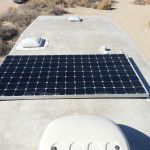
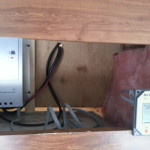

Power to the people.
Thank you Jim. As always, you are doing the work for the people for free. Thats the hallmark of a truly giving person, thank you for sharing, and thank you for all you do for so many.
Thank you Dr. K for always being so positive, encouraging and uplifting! We are still hunkered down here at The Slabs — building a 18′ x 16′ barn which is 12′ tall. In years to come, I hope to use it as a shop — maybe build a shed or two each winter and make an extra buck or two. I’ll do a blog post about it when it’s further along. We’ll be back in the Boise area towards the end of May this year — looking forward to one of our lunches!
Wow, long article & lot’s of information! Now if I can remember where I read about the big inverter hook up procedure if i ever get one …
Do you have enough battery to go to a regular 120v compressor fridge? When I had the class A we spent most of our time plugged in and the real fridge was a lot nicer than the RV 3 way was.
so the battery manufactures did away with the cycle life vs how deep the discharge? (X number of lifetime cycles at 20% draw down vs Y number of lifetime cycles at 50% vs Z number of of lifetime cycles at 20%).
The last time I looked (I think it was at the Trojan site) they had a chart for figuring the life of the battery where the more work you took out of the battery the less cycles it had in it. Drawing it deeper didn’t hurt the battery it just used it up faster… the “tanstaafl” factor.
it’s good that you have enough of the right kind of juice to do what you want to do! I’d look into the real fridge, that made life a lot better when I did that. I did have to take the door off the new fridge to get in in the front door of the class A….
==========
We don’t have enough battery yet and I’m concerned that I might have pulled the four we have down too low and maybe did some damage? It sounded the low-voltage alarm a time or two and one evening the voltage got so low that even our small inverter shut itself off. (We only turn the big inverter on as needed.) It has been a while now (a week or two?) and we have yet to see the flashing green light which indicates a full charge. Then again, it has been rainy and lots of overcast days — rather unusual given we are only 45 miles north of Mexico 🙂
==========
We have a smaller AC only dorm-size reefer back home. We might try that first and see how it goes before we get something bigger. The new inverter will run our RV two-way reefer in AC mode easily but that 250 watt load pulls our four RV/Marine batts (two of them are over three years old) down pretty quick 🙁 The trade-off between depth of discharge and service life remains. But there is no economic advantage to never pulling batts below 50% DOD which remains the most persistent urban myth. Pulling batts down as low as 80% DOD would seem to permit them to do 60% more work but it’s not quite that simple either. As the voltage drops, a given load pulls more amps and the battery drains down that much quicker. As a design parameter, the 50% figure (12.2 volts) is a good minimum to shoot for but there is no cause for alarm when the voltage creeps closer to 11.8 which we consider our ‘desired’ lower threshold though we have (very rarely) pulled it lower than that. Both inverters sound an alarm at around 10.5 volts and shut themselves off (to protect themselves!) much below that. Like anything else, if you work ’em twice as hard, they only last half as long. To support an inverter this size, we really should have a minimum of six deep-draw six-bolt batts (like Trojan’s T105) and eight would be better but our budget needs to recover some more first 🙂
==========
Thanks for your comment and thanks for following our blog!
JIM & ANNIE
==========
Fantastic article, thanks for all the info. Two questions for you. First, I have both a 1,000 watt pure sine and a 3,500 watt modified sine inverter. Can I simply connect one to the other and then one to the batteries? Or do I have to connect them independently to the batteries? Doubt that I’ll use the larger modified inverter often if ever, but since I have it, figure might as well have it available just in case…
Second, I’ve searched by can’t seem to discover what kind of ‘bolt on’ fuse you show in the photo. Not sure what to search for.
Take a look here for the fuses
https://www.amazon.com/Automotive-Replacement-Fuses/b/ref=dp_bc_6?ie=UTF8&node=15729681
Hi Rob,
Thanks for the link but we need to make sure these are DC *and* for his size inverter he’ll need a 300 amp or 400 amp bolt up fuse (or comparable circuit breaker with manual reset). As we ordered our 2/0 cables premade from custombatterycables.com it was easier to use the bolt up fuse *and* bolt it up in such a way that the smaller charging/discharging cables (*not* the ones going to the inverter) didn’t have to run their power through the resistance (inefficiency given off as heat) of the fuse.
It was just a starting place to look.
For your 1,000 watt inverter (1,000 divided by 12 volts = 83.3 amps). Inverters aren’t perfectly efficient — they pull more power than they produce. I’m thinking a 100 amp fuse and the proper size cabling will do the trick. For your larger inverter (3,500 watt divided by 12 volts = 291.7 amps). So the 300 amp fuse and 2/0 cabling we used on our 3,000 watter would be absolute minimum. Our inverter at maximum load is only 82% efficient and I suspect most affordable MSW inverters are comparable, so to actually get 3,500 watts (full load) from your inverter, it would need to pull 4,275 watts divided by 12 = 356.3 amps. If you want to be able to pull ‘full load’ you’ll want a 400 amp fuse and 1/0 cables — assuming your batts are all right next to each other *and* minimum cable length between battery bank and the inverter. All inverters receive low-voltage power directly from the battery bank and deliver 120 volt AC. This is where I began our search for 300 amp DC fuses:
https://www.amazon.com/s/ref=nb_sb_noss?url=search-alias%3Daps&field-keywords=300+amp+dc+fuses
You can search for larger ones at Amazon *or* size your cables and fuses *down* according to what you think your actual loads will be. All the fuse does is protect the cables, so always make sure your cables are rated for more amps than the fuse they are on. And there are circuit breakers which might work better and it looks like they’re cheaper too. Hope this helps and feel free to ask as many questions as you want. I’ll do my best to help.
What’s up,I check your blogs named “Adding Our 3,000 Watt Go Power! Inverter | Sailing On Dry Land” like every week.Your writing style is witty, keep it up! And you can look our website about powerful love spells.
Aside from the efficient energy output of the inverter generator, you will find that they are much quieter than other generators. This generator is designed to only provide the precise amount of energy that is required at the moment of operation, meaning that it will only be running when you actually need power.
A 3000 watt converter will only make 30 amps not 281!?!
I’m not sure which part of the post you’re responding to? But our 3,000 watt is an inverter *not* a converter. So it pulls 12 volt DC to make 120 volt AC. 3,000 divided by 12 = 250 amps of draw but inverters aren’t perfectly efficient and even the good ones (like the AIMS 3,000 watt pure sine wave inverter we’ve had since 2/24/21) have a 10% loss. So our inverter will need to pull 278 amps of 12 volt to make 3,000 watts of AC power. This is why our catastrophic fuse is 300 amps and also why we keep our 2/0 cables so short — none of them are more than 2′ long.